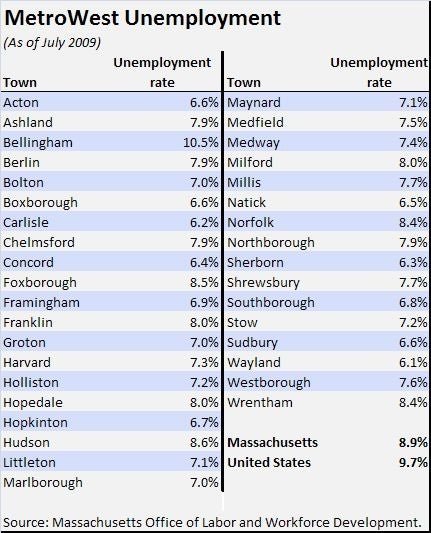MetroWest Unemployment Trends Below State, Nation

The nation's unemployment rate may be straining toward the double-digit mark, but the MetroWest area has significantly lower rates than either the nation or the state, according to the most recent unemployment figures from the state.
In July, the national unemployment rate was 9.7 percent and the state's was 8.9 percent, compared to 6.8 percent in the MetroWest area, according to statistics gathered by the MetroWest Economic Research Center (MERC) at Framingham State College. MERC also breaks out unemployment trends for what it calls the "Greater Marlborough region." That area had an unemployment rate of 7.6 percent.
The towns in MERC's MetroWest designation are Ashland, Framingham, Holliston, Hopkinton, Natick, Sherborn, Southborough, Sudbury and Wayland. The towns in MERC's Greater Marlborough Region are Hudson, Marlborough, Northborough and Westborough.
The fact that Massachusetts and MetroWest lag the nation in terms of unemployment may be because the region entered the recession later than the nation as a hole, according to Rena Kottcamp, a researcher at the state's Department of Labor. The Bay State has also had fewer job losses than other states, Kottcamp said.
But other factors are also at play.
Employment Hub
"You have major centers of employment such as Framingham, Natick and Marlborough," said Maureen Dunne, a business professor at Framingham State College and a staff member of the college's MERC. "The relative number of jobs in those communities and the size of the labor force both play a part."
Framingham dominates the towns in MetroWest with a labor force of 37,748, according to the state. Marlborough has a labor force of 23,306 and Natick's totals 19,285.
In MetroWest, Wayland, Carlisle and Sherborn had the lowest unemployment rates. All were in the 6.1 to 6.3 percent range.
The diversity of the jobs in MetroWest also contributes to lower unemployment, Dunne said.
"In Framingham for example, there are jobs for all levels of workers," Dunne said. "There are clerical, retail and waitress jobs to CEO jobs, and a lot of skill levels in between."
It doesn't hurt that MetroWest is an economic powerhouses for the state, with a 2007 combined payroll of $11.6 billion. In 2007, Framingham alone had a payroll of $3 billion while Marlborough's was $2.3 billion, Westborough's was $1.6 billion and Natick's was $1.3 billion.
Those paychecks are concentrated in manufacturing, professional business services and trade, transportation and the utilities sectors.
Of course not every town in the area has a low unemployment rate. Bellingham's rate of 10.5 percent exceeded that of all other towns in MetroWest, as well as the rate for both the state and the nation. Its rate may be influenced by Rhode Island's unemployment rate, which was the second-highest in the nation in July at 12.7 percent. Only Michigan had a higher rate in July at 15 percent.
The next highest was Hudson's, with an unemployment rate of 8.6 percent, which is still better than the state's 8.9 percent.
Fluctuation in the unemployment rates of area towns is mostly due to the types of workers that live in the town and make up its workforce, according to Fahlino Sjuib, an assistant business professor at Framingham State College and a MERC staff member.
For example, communities that have many residents that are in health and education, which have been less affected by the recession, will tend to have lower unemployment rates. And communities with more residents that are employed in industries more affected by the recession, such as manufacturing, will tend to have higher unemployment rates.









0 Comments